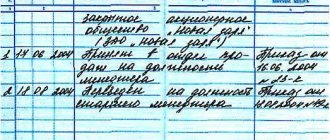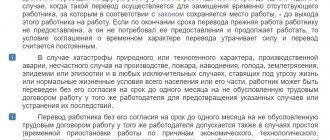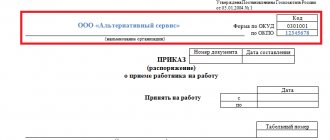Most organizations are interested in the career growth of their employees. This stimulates the production process and creates conditions for healthy competition. With the prospect of promotion, employees perform their duties better. Proper documentation of a transfer to another position is necessary in order to avoid possible legal misunderstandings. HR employees must know all stages of this procedure.
What is translation?
Before you begin processing a transfer to another position or to another department, you need to understand the terminology. It is extremely rare for company employees to work in one place for their entire career. Even if a person does not change place, then most likely he will change position.
A change in responsibilities, name of the workplace, location or other other features related to work activity is called a transfer. This is an official procedure, accompanied by the preparation of a number of documents and making relevant entries in the work book and personal card.
The transfer of an employee from one position to another must be carried out exclusively with the consent of the employee, and in accordance with current regulations.
General rules
The following types of employee transfers are legally distinguished:
1. Within the enterprise (the employer remains the same), which in turn can be:
- temporary;
- permanent.
2. External – to another employer.
The transfer is carried out with the written consent of the citizen. The following factors are exceptions:
- any circumstances that threaten the normal living conditions of the population (natural disasters, catastrophes, etc.);
- cases of production downtime.
There is no need for the employee's written consent in situations where the employer transfers him to another workplace or to another structural unit (that is, the place of work as such does not change, and the terms of the employment contract remain the same).
3. Translation for medical reasons:
- changing working conditions or performing other work for a period of up to 4 months;
- more than 4 months or on an ongoing basis;
- translation for pregnancy.
In cases where a person, if a temporary transfer is necessary for health reasons, refuses it, or the employer cannot provide proper working conditions, the employee is suspended while retaining his job. No salary is charged. If a permanent transfer is required, the employment contract will be terminated in these cases.
Important! An employee cannot be moved or transferred to another job if this is prohibited for medical reasons.
Differences between internal translation and external translation
Internal transfer can be carried out in the following ways:
- the employee’s job function changes, which does not correspond to the specified position in the employment contract;
- the transfer is made to another structural unit;
- work activity will be carried out in a different location, provided that the employer remains the same.
External entails:
- change of place of work;
- change of employer;
- changing the terms of the employment contract.
To carry out an external transfer, permission is required not only from the employee himself, but also from current and future employers.
Reasons for internal transfer to another position
There are several of them.
1. At the initiative of the employee.
In practice, the initiative from the employee comes in cases where there is a medical report requiring changes in working conditions, or the employee has every reason to believe that there is a threat to his life.
2. At the initiative of the employer:
- transition to a higher position due to the employee’s professional growth and achievements in production;
- demotion in case of failure to perform duties due to incompetence;
- transfer to another structural unit or branch;
- for a completely new position in the company that coincides with the field of activity;
- due to the deterioration of the employee’s health;
- in emergency situations (consent not required).
Types of transfers
A personnel officer, faced with the question of how to formalize the transfer of an employee to another position, must understand its type.
- Initiative transfers are carried out at the request of the employee himself, or his immediate superior, at the request of the trade union body, or on the basis of an order from the administration. The basis for this type of transfer is production necessity and the employee’s readiness to perform new duties.
- Non-initiated transfers are often mandatory for both the employee and the employer. Most often they are associated with changes in the employee’s health status or unforeseen circumstances. This type of personnel transfer must be carried out very competently, and the consent of the staff must be sought.
- Among others, it is worth highlighting permanent and temporary transfers separately. They differ not only in time frames, but also in design features. With a permanent transfer, the employee's function changes permanently. An addition to the contract is concluded with him, an entry is made in the work book. A temporary transfer is reflected only in the order.
- Transferring a pregnant woman to so-called light work or reducing production standards. This type of personnel movement is carried out upon application and on the basis of a certificate from a medical institution. In this case, the registration of a transfer to another position is always temporary. It is mandatory for the employer, but a pregnant woman can refuse. If the enterprise does not have appropriate, safe working conditions, then the woman is temporarily suspended from work, while her salary and position are retained.
- Transfer together with the employer to another location. Even if a company moves to the suburbs because rent is cheaper there, it is necessary to prepare documents for all personnel in advance. If the employee refuses such an offer, the contract with him is terminated and he is paid severance pay.
These are the main types of translations. All of them must be completed correctly, with the obligatory consent of the employee and with all necessary entries. Next, we will analyze in detail how to process the transfer of an employee to another position step by step.
Regulatory regulation
Transfer to another job or position is a permanent or temporary change in the employee’s job functions. It can be carried out either within the organization or to another location and to another leader.
This action entails a significant change in the working conditions stipulated by the contract.
Depending on the type and conditions, translation is regulated by 4 articles of the Labor Code of the Russian Federation:
- Art. 72.1 - general rules;
- Art. 72.2 - for a certain period of time;
- Art. 73 - regulates forced transfer due to the state of health of a person;
- Art. 74 - production necessity.
Note! These norms regulate not only the transfer, but also the movement of the employee, and many people confuse these concepts. The relocation does not entail a change in the terms of the employment contract and does not require the employee’s consent. That is, by moving we mean changing a cabinet, mechanism, etc.
Transfer to another position: paperwork step by step
The personnel transfer procedure should begin with justification of the need. Most often this is a document, for example, an official or memo from the head of a department. It may be a request from the employee himself, or an advertisement from the employer about vacancies.
When deciding how to formalize the transfer of an employee to another position or to another department, it is necessary to take into account voluntary consent. Even if a procedure prescribed by law is being carried out, the employee must write a statement.
Then an order for transfer is issued, it is unified, however, private organizations can use their own forms. But the process of transferring to another position does not end there. It is necessary to make entries in the accounting documents, attach copies to your personal file and sign an addendum to the employment contract.
Temporary transition
There are three types:
- replacing another employee who retains his job;
- the employer cannot find a specialist for any position, i.e. the transfer is carried out before the new employee is hired;
- in emergency cases (up to 1 month).
As a rule, temporary transfer does not last more than 1 year. An exception is the situation from the first point, when a position is reserved for an employee who is temporarily not performing his duties.
Except in emergency situations, a person must draw up a written statement of consent to make such a transfer. If an employer offers a transfer to a position with a lower salary, the citizen has the right to refuse.
Features of a temporary transition to another job or position:
- work continues in the same area;
- the employer remains the same.
Business trips do not qualify as temporary transfers. The employee is not assigned significantly new responsibilities; he only performs some official assignment, which does not entail a change in the terms of the employment contract.
Employee consent
Obtaining consent is one of the most important stages. It doesn’t matter whether these are external or internal transfers - we prepare them correctly so as not to get problems with the inspection authorities. The employee must express his consent to one degree or another, and always in writing.
In practice, most often this is:
- Application - written by hand addressed to the manager or acting official.
- Consent to transfer – it is advisable to develop such a form for mass transfers of personnel.
Written consent is the basis for issuing the appropriate order.
Transfer to another location
It refers to a type of permanent transfer with the employer.
Under another locality, in accordance with PPVS No. 2 “On the application by courts of the Russian Federation of the Labor Code of the Russian Federation”, we mean a locality located outside the boundaries of the locality in which the employee carried out his activities.
This type of transfer must be distinguished from a transfer to another structural unit, a branch or representative office. In accordance with Art. 55 of the Civil Code of the Russian Federation, branches and representative offices are not separate legal entities.
The rotation method also does not mean moving to another area, because This type of work must be determined in advance by the employment contract.
The employer must inform in advance about the fact that the organization is moving to another location. The exact period is not established by law, but from a practical point of view, the norm of Art. 74 of the Labor Code of the Russian Federation, that is, no later than 2 months. In the notice, the employer must indicate:
- new address of the organization;
- the period given to employees to provide consent to the transfer;
- date of opening of the organization in a new location;
- guarantees and reimbursement of costs in connection with the translation.
If the employee does not agree to the new terms, the contract will be terminated.
Transfer to another position: filling out an order
The basis for transfer to another position or to another unit is an order. It is published under the signature of the director. The chief accountant, heads of departments and the employee himself must become acquainted with him. A copy of the order is filed in your personal file.
This document contains all the necessary information:
- temporary transfer or permanent;
- positions;
- divisions;
- salary and wages;
- date and start time of work.
What it is
Transfer to a new position is a temporary or permanent change in an employee’s job functions. The employer does not change. In other words, this process is called “movement”. An employee can work both in one company and in its division.
The initiator of the transfer can be either the manager or the employee himself. Often he understands that he would work much more productively in a different position, as a result of which the company’s performance would change. Management should listen to the opinions of each of its employees.
It is important to note that such a transfer is not possible if the employee does not agree with it. Below we will look at the registration process, which will also take this point into account.
A transfer within a company may concern not only a change of position, but also a change of place of work. For example, often engineers working in offices travel temporarily to supervised facilities in another area. A change of department is also considered an internal transfer.
Particular attention should be paid to situations where a transfer is carried out from one unit to another.
There are several options for the development of events:
- The presence of a unit is stipulated in the employment contract with the employee.
- If the division is not specified in the document, any conditions in it will change.
- In the case when the unit is not mentioned in the employment contract, but the working conditions and functions of the employee remain the same.
Only the last case of the three can be considered as displacement. The first two should be considered by the HR department as a process of changing the employee's position. Registration is carried out accordingly.
Let's talk about what the law says about moving within one company.
Making an entry in the work book
Entries are made in the work book about all permanent transfers, as well as temporary ones, if they are the basis for calculating preferential length of service. This entry is strictly required.
The record indicates the basis for the transfer, and both the name of the position and the name of the department to which the employee is being transferred are written down in full, without any abbreviations.
In addition, it should be taken into account that a translation formally means a change in the name of an organization or division. In this case, a mass transfer is issued, with the issuance of a single order and general consent.
When completing employee transfers, do not leave out key steps. This will help avoid many problems with inspection authorities.
In what cases can transfer be avoided?
Labor standards provide for the possibility that official re-registration, as well as a positive response from the employee, is not needed. Article 72.1 of the Labor Code of the Russian Federation gives the employer the right to move him to another facility, including another branch. In this case, three criteria must be met:
- No major changes to the provisions of the concluded employment agreement.
- There are no contraindications issued by a health care institution on the basis of current federal laws.
- The transition is not permanent.
If the employment contract stipulated that professional activities would be carried out only within one department, then, accordingly, one of the specified provisions would be violated and official registration would have to be carried out. For a temporary transition, the duration of which should not exceed 1 month, it will be sufficient to sign an internal order. It is important that the reasons are serious, Art. 72.2 of the Labor Code of the Russian Federation calls them:
- man-made disasters;
- large-scale accidents at the enterprise;
- downtime due to economic difficulties.
In practice, if a temporary transfer was made in the absence of the employee’s written consent, but the latter began performing new functions and did not express any objections, then everything will be in accordance with the law. In addition to the listed conditions, the main thing here is compliance with the deadline, which cannot exceed 1 year, as well as the continuation of activities within the framework of a specific production. It is worth considering that the level of average wages and salaries cannot become lower than it was before.
The Plenum of the Supreme Court of the Russian Federation clearly explains that changes not related to professional duties, as well as a change in the structural unit and location of the employer, cannot be interpreted as a transfer (Resolution No. 16 of March 17, 2004).
How to apply
The registration procedure depends on what kind of movement is taking place within the organization, temporary or permanent.
In a temporary setting, the functions of the HR department employee are as follows:
- Acceptance of an application from an employee about the desire to take a new position (formal consent, which is written on the basis of a memorandum from the employee’s immediate supervisor, certified by the director of the organization or division). A sample application is presented below:
During the course of their working life, every employee experiences career ups and downs. Often they occur within the same employer.
There are many reasons for this, and changes can consist of both promotion and demotion depending on work results, relations with the boss, or changes in the owner of the company. But like any other personnel procedure, changing the status of an employee requires compliance with certain rules.
What can’t the “Personnel Transfer” document do?
It would seem that “Personnel Transfer” can change everything the user wants. However, it is not. With this document it is impossible to transfer an employee working under the GPC to the staff. To do this, you will have to create “Recruitment”.
It is also not possible to transfer several employees at the same time. For this purpose, use the document “Personnel transfer list”.
It is impossible to change the organization in which an employee works through a personnel transfer, and such a need may arise, for example, when a branch is separated into a separate legal entity. Then you will need a document “Transfer to another employer”. This document is the processing that creates the necessary documents required in such cases.
How to transfer an employee to another position at the initiative of the employer?
If there are grounds for transferring an employee to another position, the head of the organization has the right to implement the designated process. The fundamental condition for a transfer at the initiative of the employer is the need to obtain written consent.
Depending on the type and grounds, the procedure for an employee’s transition to a new workplace may differ. In standard form, the employer’s procedure is as follows:
- If the director of an enterprise has a need to transfer a specific employee to another position, it is necessary to first find out whether such a transfer is permissible and whether it does not contradict the health status of the subordinate;
- Next, you need to notify the employee of the employer’s desire to transfer him to a new workplace two months before the expected date of transfer. This is done by means of a written notice sent to the worker;
- After reading the written notice, the subordinate draws up a document in which he notes his consent or refusal;
- If the employee approved the employer’s initiative and the parties agreed on the terms of further cooperation, it is required to document all the nuances that relate to the employee’s work activity in the new conditions;
- At the end, the head of the company issues an order.
It seems important to note some features that relate to the employer’s procedure when transferring an employee to a vacant post in the event that the designated procedure differs from the standard one.
Features of transferring an employee to a new position:
- If the employer plans to transfer a subordinate to a new workplace on a temporary basis, there is no need to issue a notice to the employee. This rule applies when the worker will perform the work duties of a colleague if he is on sick leave, vacation or on a business trip;
- When temporarily transferring an employee, it is not necessary to make additional changes to the content of the work agreement or to the employee’s work certificate. It will be sufficient to confirm the transfer to another position by issuing an order;
- If an employee is transferred to work in another organization, then the cooperation agreement with the worker at the previous place of work is terminated, and another agreement is concluded at the new one.
Is it possible to transfer an employee without his consent?
If the transfer of an employee is carried out at the request of the head of the enterprise, he is obliged to obtain written consent from the subordinate. However, labor legislation provides a list of cases on the basis of which an employee can be transferred without his consent. To prevent cases of violation by an employer of an employee’s rights, the Labor Code defines the conditions for transferring an employee to a new place of work without his consent:
- The maximum length of time during which an employee will work in another position is one month;
- Payment for the labor activity of a subordinate, according to article No. 72 of the Labor Code of the Russian Federation , is made according to the time worked or based on the complexity of the work performed. At the same time, the amount of earnings when transferring to another position cannot be less than when working in the previous one;
- If an employee is not allowed to perform duties due to health reasons, the employer does not have the right to transfer him;
- To transfer an employee to another post, there must be compelling reasons. These include: the need to prevent disasters and emergencies that may pose a threat to people’s lives or the employer’s property;
- earthquake;
- development of epidemiological diseases;
- preventing forced downtime of the organization.
What documents are required?
The procedure for transferring an employee to a new position is strictly regulated by labor legislation. Failure to comply with the prescribed conditions is punishable by law. For the correct implementation of the process, it is important to pay special attention to the documentary side of the issue and properly draw up the necessary acts.
The primary document, the publication of which initiates the process of transferring an employee to another position, is a notification on behalf of the head of the enterprise. When writing the notice, the employer must note the personal data and position of the employee whom he plans to transfer, the basis for the transfer and the post that is offered to the subordinate. Finally, it is necessary to draw the employee’s attention to the opportunity to issue a refusal.
At the next stage, the employee must draw up a written act as a sign of his consent to the transfer and change of occupation. The content indicates the personal data of the participants in the cooperation and the consent of the subordinate to transfer.
In addition to the indicated documents, it is necessary to make changes to the following acts:
- Employment contract . If the working conditions change after the transfer, all adjustments are negotiated between the employee and the employer and are noted in an additional agreement to the work contract;
- Order . The order has a strictly unified form T - 5 . Based on the order, the employee is transferred to a new post from the day indicated in the contents of the order;
- Worker's personal card. If an employee is transferred to a new workplace on a permanent basis, information about the upcoming transition is reflected in the person’s personal records;
- Employment history. In addition to the personal card, information about changes in the employee’s work activity is entered into the work certificate.
Employee refusal
Cases of an employee refusing to be transferred to another position are not uncommon. Especially when it comes to demoting a worker. If there are other options for employing a person and continuing cooperation, the manager offers them to the employee, and may also remove him from professional duties for up to 4 months without pay. In the absence of valid reasons for refusal, the employer has the legal right to terminate the employment contract.
To confirm the legality of the dismissal procedure, the head of the company records the refusal through an appropriate act. The document reflects the personal data of the employee, the basis for dismissal, as well as the article of the Labor Code of the Russian Federation in accordance with which the process is carried out, namely 73 and 77 .
Reasons
Regardless of who initiates the transfer of an employee to a new position, it is necessary to follow the procedure and also have legal grounds.
An employee's transfer to another position is carried out on the following grounds:
- The emergence of new positions at the enterprise that correspond to the knowledge and qualifications of the worker;
- Promotion or demotion;
- Reduction in the number of working personnel;
- Structural changes at the enterprise;
- Change of location of the company;
- An employee has the right to be transferred to another position if the results of a medical examination reveal a deterioration in the employee’s health. If health problems are a consequence of the worker’s professional activities, when transferred to another workplace, the employee retains the same salary amount.
What will be considered a violation
The main violations during transfer relate to the lack of employee consent to the transfer in cases where it is necessary. Subsequently, it will be impossible to prove otherwise. You should also distinguish between a temporary transfer and a permanent one when making changes to documents.
Article 72.1 stipulates that if a person’s health does not allow it, it is prohibited to transfer him to another position that would affect this condition.
If a forced transfer took place without consent, a reduced rate of remuneration for the new position will be considered a violation.
Moving to a new position is a simple procedure that does not require special knowledge from the personnel officer. You should carefully study the legislation and act within strictly defined limits.
Document "Personnel transfer"
How to find a document in the program menu? The “Personnel Transfer” document can be opened in several ways.
The first method is the simplest: in the main menu of the program we find the item “All personnel documents” or the item “Receptions, transfers, dismissals”.
Fig.1 Document location
In both cases, we will be taken to the list of personnel documents, and using the “Create” button we can open the personnel transfer form (or personnel transfer by a list, which will be written about a little later).
Fig.2 Personnel transfer and list transfer
This is the most common way to launch a document form. The second way is to call the personnel transfer form directly from the employee’s card.
Fig.3 Complete the transfer
The third method, the most convenient, is to display the personnel transfer log in the “Personnel” section. To do this, in the “Frames” section, you need to call and open “Navigation Settings”, as shown in the figure below.
If you need help, you can contact HR experts. The first consultation is free!
Fig.4 Navigation settings
After that, add the “Personnel Transfers” journal to “Selected Teams”.
Fig.5 Panel settings
Now this section has appeared in the personnel menu.
Fig.6 Personnel transfers in the thematic menu
Now you don’t have to look for a personnel transfer in the general list of documents, but immediately launch the list, where you can create it using the “Add” button without additional actions. When carrying out a personnel transfer, compliance with the staffing schedule is checked. The program controls it, even if the “Staffing control” checkbox is not checked in the settings. If it is, a note about it will certainly appear in the personnel transfer log.
Fig.7 Mark in the journal
If you start to find out where this mark comes from, the program will issue a detailed report on the availability of vacancies for this position in the staffing table. At the same time, the system will not prohibit posting and hiring an “extra” employee for this position, as was the case in ZUP 2.5. Its job is to warn, and the final decision remains with the user. Therefore, organizations that have strict control over staff often ask for improvements to this functionality.
So, let’s open the “Personnel Transfer” document.









